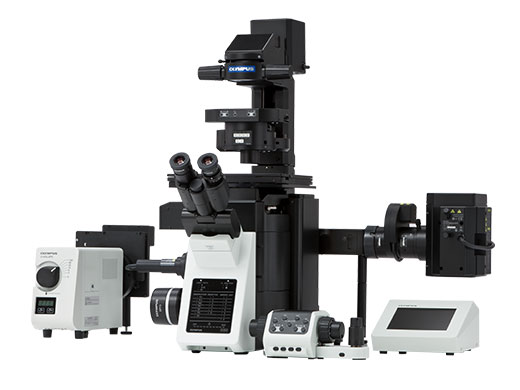Currently integrated into IXplore Systems
The Olympus IX83 inverted microscope has been integrated into our IXplore systems. IXplore Systems are designed to provide solutions-based packages that suit your research application needs.
Expandable to Meet Growing Research Needs
The fully-motorized IX83 is designed to satisfy a variety of research needs. With additional modules providing expanded functionality, both microscope options enable a multitude of imaging techniques, ranging from casual documentation to long-term time-lapse imaging and other demanding techniques.
The unique open frame of the IX83 provides ready access to the light path, thus making it easy to add or change modules. A variety of deck modules can be easily exchanged to add or remove functions as needed. With a simple slide-in design, the TruFocus Z drift compensator module can be easily added to any IX83 system to maintain continuous focus throughout an extended time-lapse experiment. |
IX83: Two-deck System

Enables high-speed, fully automated device selection during live cell research and advanced image acquisition. The two-deck configuration provides excellent expandability. |
IX83: One-deck System

An intelligent, motorized microscope featuring a large field number (FN22, left side port) and TruFocus compatibility, thus creating a new standard for live cell imaging. |
Applications
Light-induced Oscillatory/Sustained Expression of Ascl1 in Neural Progenitor Cells.
|
|
For generating oscillatory expression of transgene, blue-light was illuminated for 1 min with a 3-hr interval, which maintaining proliferating NPCs.For achieving sustained expression of transgene, blue-light was illuminated for 2 min with a 30-min interval which promoting neuronal fate determination.
Image data courtesy of:
Itaru Imayoshi and Ryoichiro Kageyama
Institute for Virus Research, Kyoto University |
Reference material:
Itaru Imayoshi, Akihiro Isomura, Yukiko Harima, Kyogo Kawaguchi, Hiroshi Kori, Hitoshi Miyachi, Takahiro Fujiwara, Fumiyoshi Ishidate, and Ryoichiro Kageyama “Oscillatory Control of Factors Determining Multipotency and Fate in Mouse Neural Progenitors” Science 1242366 Published online 31 October 2013.
Synthetic ERK Activity Propagation by A Light-Switchable System
Reference:
Kazuhiro Aoki, Yuka Kumagai,Atsuro Sakurai,Naoki Komatsu,Yoshihisa Fujita,Clara Shionyu,Michiyuki Matsuda. “Stochastic ERK Activation Induced by Noise and Cell-to-Cell Propagation Regulates Cell Density-Dependent Proliferation” Molecular Cell,17 October 2013.
Real-time Imaging for Ring1BYFP/YFP ME
|
|
Constitutive exchange of Ring1B-YFP at the PRC1 clusters. A PRC1 cluster in Ring1B YFP/YFP MEFs was subjected to photo-bleaching and subsequent sequential imaging.
Image data courtesy of:
Kazuhiro Aoki and Michiyuki Matsuda
Imaging Platform for Spatio-Temporal Information, Graduate School of Medicine, Kyoto University |
|
|
Constitutive exchange of Ring1B-YFP at the PRC1 clusters. A PRC1 cluster in Ring1B YFP/YFP MEFs was subjected to photo-bleaching and subsequent sequential imaging.
Image data courtesy of:
Kyoichi Isono, and Haruhiko Koseki
Laboratory for Developmental Genetics, RIKEN Center for Integrative Medical Sciences (IMS-RCAI) |
Reference:
SAM domain polymerization links subnuclear clustering of PRC1 to gene silencing. Isono K, et al. Developmental Cell, 26, 565-577 (2013).
Brain Slice Culture Glia Cell
|
|
Image data courtesy of:
Masafumi Minami
Department of Pharmacology, Graduate School of Pharmaceutical Science, Hokkaido University |
Trans-mesenteric Migration of Enteric Neural Crest Derived Cells (ENCCs)
|
|
Image data courtesy of:
Hideki Enomoto
Neuronal Differentiation and Regeneration, RIKEN CENTER FOR DEVELOPMENT BIOLOGY |










